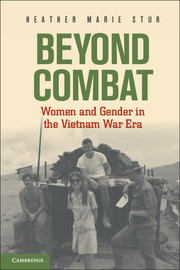Book contents
1 - Vietnamese Women in the American Mind
Gender, Race, and the Vietnam War
Published online by Cambridge University Press: 05 June 2012
Summary
Beauty queen candidates decked out in sequins, black lace gloves, false eyelashes, and padded bras, cloaked in the scent of hairspray, filled the Rex Movie Hall in Saigon on a May evening in 1971. As electric fans tried in vain to cool the packed room, young Vietnamese women, their made-up faces glistening, paraded across a catwalk for audience members who drank Pepsi, smoked, and ate ice cream. The spectacle was Saigon's first beauty pageant, attended by a crowd of Saigon's small but influential middle class, along with American diplomats. The high ticket prices kept most soldiers – American or Vietnamese – from going. Rejecting the miniskirt, which had become one of the symbols of an American cultural invasion, the women in the pageant wore the ao dai, a traditional Vietnamese outfit consisting of a long dress with thigh-high slits on either side, worn over loose-fitting pants. As one of the promoters of the pageant put it, “Saigon is invaded by miniskirts and hot pants, and we are opposed to it. We think the Vietnamese women are so beautiful in their own dress they do not need to vulgarly display their charms.” Despite the attempts to stress Vietnamese cultural autonomy, the pageant blatantly signified Saigon's Westernization, from the audience members’ consumption of American soft drinks to contestants’ desires to become Hollywood stars. It was a pageant of contradictions with Vietnamese women at the center, and it encapsulated a set of images and ideas that had become hallmarks of U.S. intervention in Vietnam. The women were emblems of exotic sexuality, but also of Vietnamese modernity, objects of desire whose superficial familiarity masked their intractable otherness. Those contradictions reflected the contentious notions of masculinity and femininity that shaped women's roles during the Vietnam War, pointing to the unresolved ideological tensions that would play a crucial role in the unraveling of the American military mission.
By 1971, the United States, deeply entrenched in the Vietnam War, was slowly extricating itself from the conflict. The ideology that had influenced American intervention in Vietnam had become embedded in the culture of the war, reflected in a series of images of Vietnamese women, which dictated their daily interactions with American soldiers. U.S. policymakers, as well as many ordinary citizens influenced by newspaper and magazine coverage, viewed Vietnam through the lenses of gender and race, seeing a land and a people that were at once alluring and dangerous. Three images, each with a long history in western attitudes toward Asia, were particularly important in relation to Vietnamese women. First, the women represented the dangerous Asia that threatened U.S. interests in the Cold War world. Second, they were damsels in distress who needed to be protected. Third, they were sexual objects to be dominated and possessed. The contradiction between the image of protection and the reality of domination, justified by the need to ward off the “dragon lady,” completed a contradictory loop in which the United States dominated what it was protecting.
- Type
- Chapter
- Information
- Beyond CombatWomen and Gender in the Vietnam War Era, pp. 17 - 63Publisher: Cambridge University PressPrint publication year: 2011

